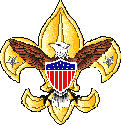| MERIT BADGES |
|
|
|
|
| Note: Eagle Required are in Italics |
"A"
American
Business
American Culture
American Heritage
American Labor
Animal Science
Archaeology
Archery
Architecture
Art
Astronomy
Athletics
Atomic Energy
Auto Mechanics
Aviation
"B"
Backpacking
Basketry
Bird Study
Bugling
"C"
Camping
Canoeing
Chemistry
Cinematography
Citizenship
Community*
Citizenship Nation*
Citizenship World*
Climbing
Coin Collecting
Collections
Communications*
Computers
Cooking
Crime Prevention
Cycling*
"D"
Dentistry
Disability Awareness
Dog Care
Drafting
"E"
Electricity
Electronics
Emergency
Preparedness**
Energy
Engineering
Entrepreneurship
Environmental
Science*
"F"
Family Life*
Farm Mechanics
Fingerprinting
Fire Safety
First Aid*
Fish & Wildlife Mgmt.
Fishing
Fly Fishing
Forestry
"G"
Gardening
Genealogy
Geology
Golf
Graphic Arts
"H"
Hiking
Home Repairs
Horsemanship
"I"
Indian Lore
Insect Studies
"J"
Journalism
"K"
"L"
Landscape Architecture
Law
Leatherwork
Lifesaving**
"M"
Mammal Study
Medicine
Metalwork
Model Design & Building
Motorboating
Music
"N"
Nature
"O"
Oceanography
Orienteering
"P"
Painting
Personal Fitness**
Personal Management*
Pets
Photography
Pioneering
Plant Science
Plumbing
Pottery
Public Health
Public Speaking
Pulp and Paper
"Q"
"R"
Radio
Railroading
Reading
Reptile & Amphibian Study
Rifle Shooting
Rowing
"S"
Safety
Salesmanship
Scholarship
Sculpture
Shotgun Shooting
Skating
Skiing
Small Boat Sailing
Soil & Water
Conservation
Space Exploration
Sports**
Stamp Collecting
Surveying
Swimming**
"T"
Textile
Theatre
Traffic Safety
Truck Transportation
"U"
"V"
Veterinary Medicine
"W"
Water Skiing
Weather
Whitewater
Wilderness Survival
Wood Carving
Woodwork
"X"
"Y"
"Z"
 Forestry ForestryRequirements 1984 |
- Prepare a field notebook, make a collection, and identify 15 species of trees or wild
shrubs in a local forested area. Include a written description of:
- Identifying characteristics of leaf, twig, and fruit samples
- The habitat in which these trees or shrubs are found
- Chief ways each tree or shrub is used by human or wildlife
- The forest's successional stage, what its history has been, and what its future is
- Do ONE of the following:
- Collect and identify wood samples of 10 species of trees. List several ways each species of wood can be used.
- Find and examine several stumps or logs that show variations in growth rate in their ring patterns. Prepare a field notebook describing their location and discuss possible reasons for the variations.
- Be able to do the following:
- Describe contributions forests make to
- Our economy in the form of products
- Our social well-being
- Soil protection and increased fertility
- Clean water
- Clean air
- Wildlife
- Recreation
- Tell which watershed or other source your community relies on for its water supply.
- Describe contributions forests make to
- Be able to describe what forest management means, including:
- Multiple-use managemen
- Even-aged and uneven-aged management and silvicultural systems associated with each type
- Intermediate cuttings
- How prescribed burning and related forest management practices are used
- Do ONE of the following:
- Visit a managed public or private forest area with its manager or someone familiar with
it. Write a brief report describing:
- The type of forest
- The management objectives
- The forestry techniques used to achieve the objectives
- Take a trip to a logging operation or wood-using industrial plant and write a brief
report describing:
- The species and size of trees being harvested or used
- Where the trees are going to or coming from
- What products are made from the trees or at the plant
- How the products are made
- How the products are used
- How waste materials from the logging operation or plant are disposed of or utilized
- Visit a managed public or private forest area with its manager or someone familiar with
it. Write a brief report describing:
- Be able to do the following:
- Describe the damages to forests that result from:
- Wildfire
- Insects
- Tree disease
- Overgrazing
- Improper harvest
- Tell what can be done to reduce these damages.
- Tell what you should do if you discover a forest fire and how to control it.
- Describe the damages to forests that result from:
- Do ONE of the following:
- Assist in carrying out a project that meets one or more of these objectives: timber stand improvement, watershed improvement, wildlife habitat improvement, recreation are improvement, or range improvement.
- Take part in a forest fire prevention campaign in cooperation with your local fire warden, forester, or counselor.
- Visit with one of more local foresters and write a brief report including education, qualifications, career opportunities, and objectives relating to forestry.
|
||||||
Last Update May 15, 2023

.jpg)
